#Sam'al
Explore tagged Tumblr posts
Text

Kuttamuwa Stele Sam´al / Bit Gabbari Modern Zincirli Höyük, Turkey c. 8th Century BCE
The stele measures three feet tall and two feet wide. It was a stele for Kuttamuwa, an 8th-century BCE royal official from Sam'al who ordered an inscribed stele, that was to be erected upon his death. The inscription requested that his mourners commemorate his life and his afterlife with feasts "for my soul that is in this stele." It is one of the earliest references in a Near East culture to a soul as a separate entity from the body.
The translation of the stele:
"I am KTMW (Kuttamuwa), servant of Panamuwa, who commissioned for myself (this) stele while still living. I placed it in an eternal chamber and established a feast (at) this chamber: a bull for Hadad Qarpatalli, a ram for NGD/R ṢWD/RN, a ram for Šamš, a ram for Hadad of the Vineyards, a ram for Kubaba, and a ram for my “soul” (NBŠ) that (will be) in this stele. Henceforth, whoever of my sons or of the sons of anybody (else) should come into possession of this chamber, let him take from the best (produce) of this vine(yard) (as) a (presentation)-offering year by year. He is also to perform the slaughter (prescribed above) in (proximity to) my “soul” and is to apportion for me a leg-cut." Source: Wikipedia
#Kuttamuwa#funerary stele#stele#table#food#offering#chair#aramean costume#aram#aramea#canaan#phoenicia#syria#levantine gods#pagan gods#polytheism#archeology#magic
15 notes
·
View notes
Photo
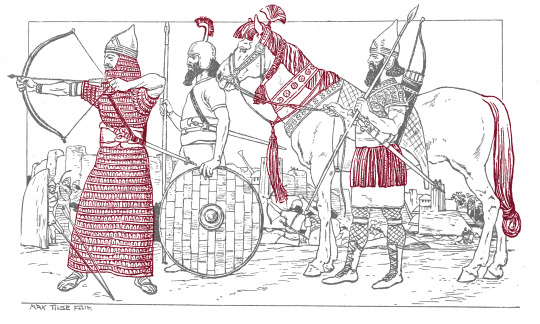

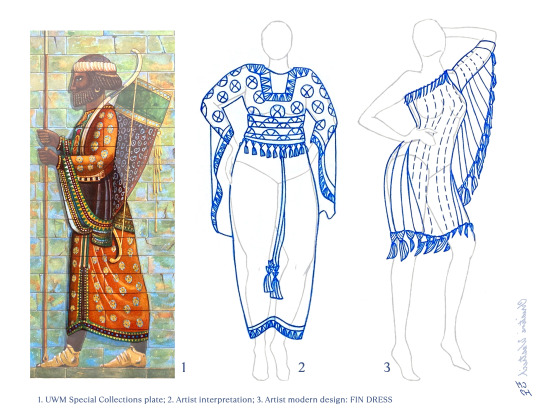
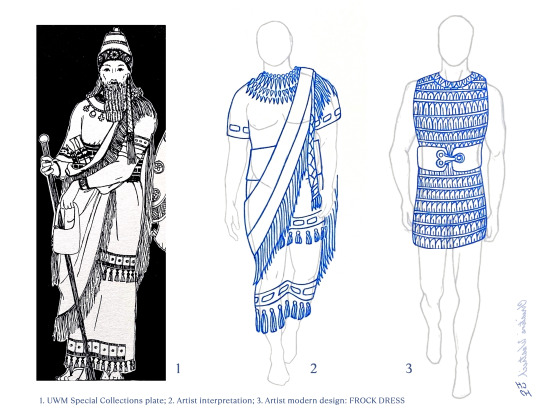
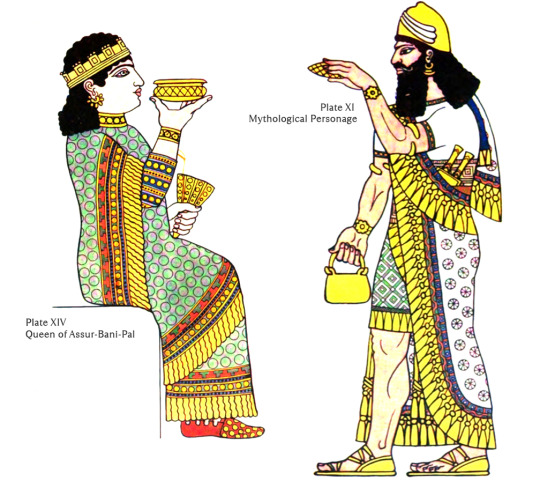
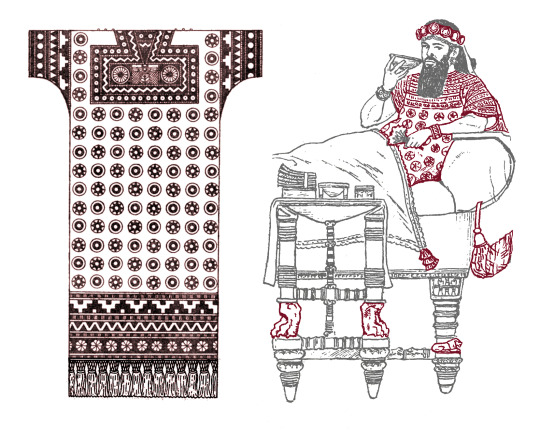
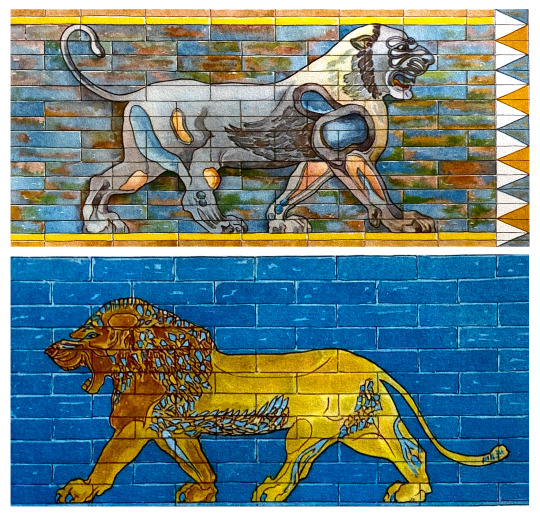
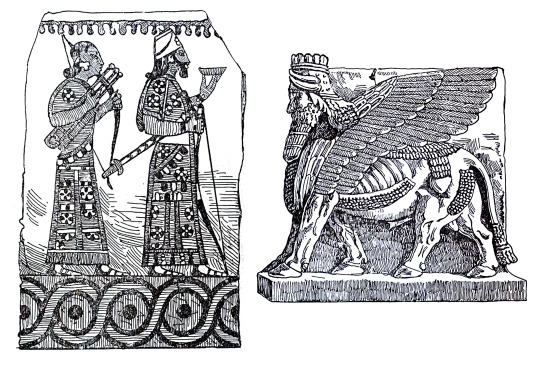
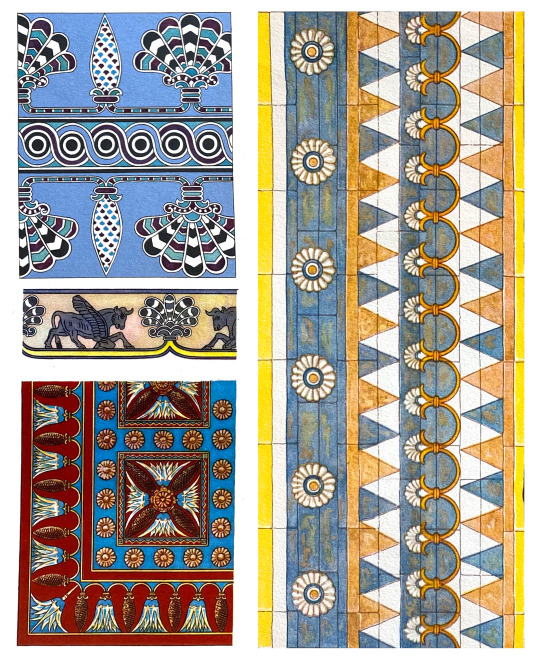
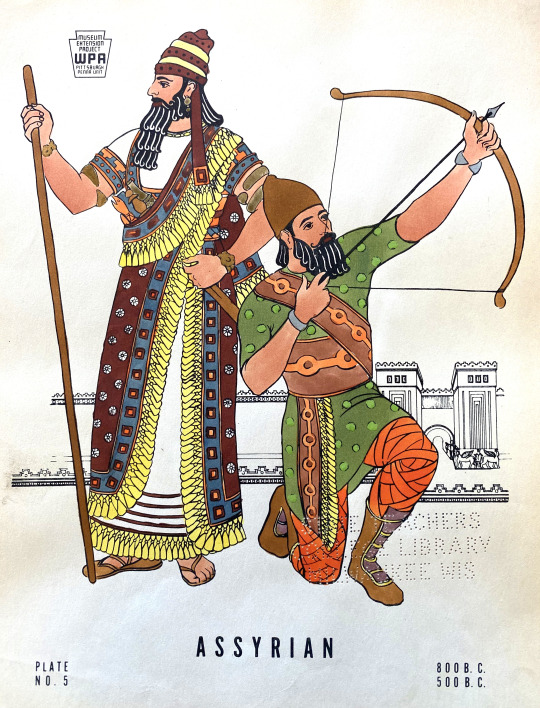
Fashion Friday: The Fringe Binge
Today, I continue my UWM Special Collections exploration of fashion through the ages with Assyrian costume. You may recall from last week’s post that I am conducting an independent study in Special Collections this semester on the history of costume and fashion to help inform my own practice.
The ornamentation of this ninth-century BCE culture is dramatic with complex layering, repeating patterns, and textile borders, e.g., dual beltings, rosettes, and lots of tassels. Sensibilities include shawls and slings, scaling armor, and animal fur, all invoking a fringe motif.
A significant source of Assyrian wearables are from one particular excavation site known as Sam'al or Zincirli in southern Turkey, its rulers changing over its 2,500 yearlong existence as a trading hub and crossroads of multicultural peoples. The buried fortress and the kingdom itself ended in the Neo-Assyrian period of the late seventh century BCE.
Among the prizes of this modern-day dig are two depictions of the lion: a formidable threat often shown in defeat in the King's hunt, and the lion as a hybrid deity—the lamassu— protecting the venerated empire.
My first fashion plate is inspired by an ancient fragment with rosette and fringe detail on both figures’ shawls and tunics, while the man's tarbush also has rosette and tassel. Can you spot the decorative muses in the additional plates?
Here is a listing of sources for my designs and featured plates:
1) Assyrian warriors from Geschichte des Kostums, published in New York by E. Weyhe, circa 1905.
2-3) My interpretation and contemporary design of the FIN and FRINGE DRESS inspired by "Caldeo-Assiro" plates VI and VII from volume one of Gli Stili Nella Forma e nel Colore, Rassegna dell’ Arte Antica e Moderna di Tutti i Paesi published in Torino by C. Crudo & Co. in 1925.
4) My interpretation and contemporary design of the FROCK DRESS inspired by a detail from plate III, “Ancient Mede, Assyrian and Persian Costume”, in A Short Description of Historic Fashion published in New York by the Columbia University Teachers College Bureau of Publications in 1925.
5-6) Figures and tunic design from Ancient Egyptian, Assyrian, and Persian Costumes and Decorations published in England by A. & C. Black in 1920, available online in the UWM Libraries Collection. Recumbent king from Geschichte des Kostums, published in New York by E. Weyhe, circa 1905.
7-9) Plates from volume one of Gli Stili Nella Forma e nel Colore, Rassegna dell’ Arte Antica e Moderna di Tutti i Paesi published in Torino by C. Crudo & Co. in 1925.
10) “Assyrian” plate from Costumes of the World, 100 Hand Colored Plates from Ancient Egypt to the Gay Nineties, published by the Works Progress Administration, Pittsburgh, Pennsylvania unit, ca. 1940.
The Zincirli archeological site also offers proof of the Assyrian sensitivity to diversity; artifacts have heterogenous designs and inscriptions with dynamic beliefs in the afterlife, a mélange border culture. Assyrian commerce stretched from eastern Europe to northern India, with modern day Armenia, Israel, Syria, and Iraq in between. In the ninth century BCE, it was this fringe Assyrian empire that dominated the land.
View my post on Egyptian fashion design from last week.
View more posts from Geschichte des Kostums.
View other posts from A Short Description of Historic Fashion.
View more posts from Costumes of the World.
View more posts from Gli Stili.
View more Fashion Friday posts.
—Christine Westrich, MFA Graduate Student in Intermedia Arts
#Fashion Friday#graduate research#Neo-Assyrian Empire#Assyrian fashion#Assyrian costume#fashion#fashion plates#fringe#Zincirli#Sam'al#Assyrian design#costume design#Christine Westrich#Geschichte des Kostums#A Short Description of Historic Fashion#Costumes of the World#Gli Stili Nella Forma e nel Colore Rassegna dell’ Arte Antica e Moderna di Tutti i Paesi
1K notes
·
View notes
Photo

Stele representing a king and attendant Excavated at Zincirli (ancient Sam’al), Turkey ca. 830-750 BCE Basalt
Vorderasiatisches Museum, Berlin (S 6580)
(On display in the exhibition “Royaumes oubliés” at the Louvre, 2019)
#zincirli#sam'al#neo-hittite#hittite#aramaean#vorderasiatisches museum#ancient near east#archaeology#art history
138 notes
·
View notes
Photo



Ishtar seated on a throne riding a lion.
Part of procession of gods on Victory stele of Esarhaddon.
At the height of his power, the Assyrian king Esarhaddon (680-669 BCE) led his troops all the way to Egypt to subdue his rival, Taharqa. During the campaign he plundered Memphis, taking capitve the Egyptian crown prince portraied here on his knees. On the homeward march, the king also stopped several times in Syria to exact obedience and tribute from the rulers of Syrian cities. To commemorate this successful campaign, he ereced a number of victory stelae, inclding this one at Sam’al.
The message of the stele would have been obvious even to those whou could not read: the fate of the two prisoners on the obverse, with their mouths gagged and their feet shackled, was intended to deter any vassals wishing to free themselves from Assyrian rule. The stele also bore a message about the internal politics of the empire: by showing, on the side panels, the crown princes Shamash-shum-ukin and Ashurbanipal wearing Babylonian and Assyrian costume respectively, Esarhaddon was also settling the question of the royal succession.
Source: Pergamon Museum
#ishtar#inanna#assyria#mesopotamia#ancient near east#babylon#babylonia#ashurbanipal#esarhaddon#sam'al#stele#addad#ashur
32 notes
·
View notes
Photo


Aramaic inscription describing the capture of a creature called the “devourer” which produces “fire” (Sam'al, Turkey, c. 850 – 800 BC).
The inscription was written by Rahim son of Shadadan, on a stone container that had originally been used to store cosmetics. The blood of the devourer was used to treat someone who had been suffering from its “fire”. Pictures on the containers show a centipede, a scorpion, and a fish – the “devourer” may have been a scorpion.
This is the oldest Aramaic inscription ever found. The writing itself is shown in the second photo.
75 notes
·
View notes
Link
A 2,800-year-old incantation, written in Aramaic, describes the capture of a creature called the "devourer" said to be able to produce "fire."
Discovered in August 2017 within a small building, possibly a shrine, at the site of Zincirli (called "Sam'al" in ancient times), in Turkey, the incantation is inscribed on a stone cosmetic container. Written by a man who practiced magic who is called "Rahim son of Shadadan," the incantation "describes the seizure of a threatening creature [called] the 'devourer,'" wrote Madadh Richey and Dennis Pardee in the abstract of a presentation they gave recently at the Society of Biblical Literature annual meeting. That event took place in Denver between Nov 17 and 21...
115 notes
·
View notes
Photo

Lion sculptures (Basalt) from the city gate of Sam'al of Neo Syro Hittite period
141 notes
·
View notes
Photo
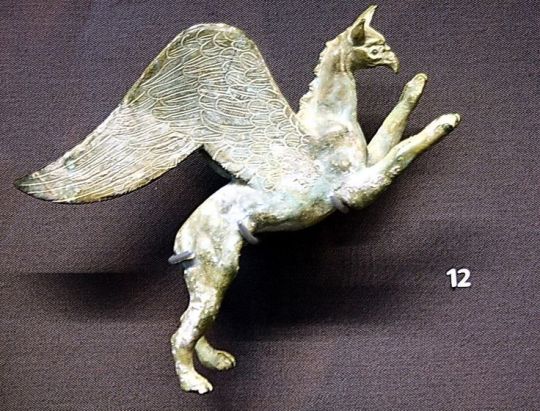
Lion sculptures (Basalt) from the city gate of Sam'al of Neo Syro Hittite period
II millenar BC
0 notes
Text
Excavation Reveals Hittite Empire Ransacked Turkish City of Sam'al Before Destroying Babylon
Archaelogists have uncovered charred ruins of the Turkish city Sam’al which was revealed to have been burned by the Hittite Empire on their way to destroying Babylon. “It’s an incredibly lucky find. Every archaeologist hopes for an intact destruction layer because it gives you a snapshot of a day in the life of this town,” […]
The post Excavation Reveals Hittite Empire Ransacked Turkish City of Sam'al Before Destroying Babylon appeared first on AWorkstation.com.
source https://aworkstation.com/excavation-reveals-hittite-empire-ransacked-turkish-city-of-samal-before-destroying-babylon/
0 notes
Photo

Reconstructed Guardian Lion Sculpture from the Inner Gate of the Aramean Citadel of Sam'al (formerly Yadiya under Hittite rule) near modern Zincirli Höyük, Turkey 10th-8th century BCE by mharrsch on Flickr.
3 notes
·
View notes
Text

Aramean Stele of Man Carrying Gazelle Stone relief from the north of the Aramean Royal Palace at Sam'al in Bit Gabbari Modern Zincirli Höyük, Turkey Currently in Pergamon Museum, Berlin c. 8th Century BCE
Source: Baramyo
#aram#aramea#aramean costume#canaan#phoenicia#syria#levantine gods#pagan gods#polytheism#archeology#magic
5 notes
·
View notes
Photo

Orthostat of King Bar-Rakib (744-727 BCE) Excavated at Zincirli (ancient Sam’al), Turkey Vorderasiatisches Museum, Berlin VA 2817
From the Staatliche Museen zu Berlin website:
This orthostat from the Northern Hall of the city of Sam’al belongs to a group of relief-sculpted stone plaques that represent scenes of the life to come. The relief depicts the lord seated on a throne, with an official standing before him seeming to take instructions. A fly whisk-carrier behind the throne is visible only from the side.
Bar-Rakib holds in his left hand a symbol of rulership with a palmette top, and the right hand is slightly raised. The scribe carries under his left arm the bound writing-tablets and in his last hand a container in which scribal implements are kept. The beard and hairstyle of the king are indebted to the Assyrian fashion, by which he signals his vassal status to the Assyrian ruler. The headgear of the enthroned king, a smooth cap with raised side-flap and tassel, and the standing figure’s long garment portray the local dress. Because the smooth garment is only flatly carved, like the footwear, the zones of bare body and the headgear would be scarcely differentiated, were it not for the careful working of the heads and the details of the throne, footstool, and hems of garments. Archaeological finds confirm that these depict wooden pieces of furniture with metal decorative elements of copper or bronze.
The one-line Aramaic inscription is inscribed on the upper part of the picture. The text next to the ruler’s head proclaims: “I am Bar-Rakib, son of Panammuwa,” right next to the astral symbol reads: “My lord, Ba’al-Harran.” This “Lord of Harran” is identifiable with the moon god, depicted as a moon-disc and crescent, which are fitted with a small handle with grip and pommel.
#bar-rakib#ancient art#zincirli#sam'al#archaeology#art history#vorderasiatisches museum#staatliche Museen zu berlin#pergamonmuseum#neo-hittite#aramaean#aramaic#syro-hittite#iron age#ancient near east
78 notes
·
View notes